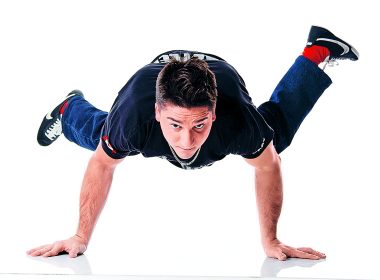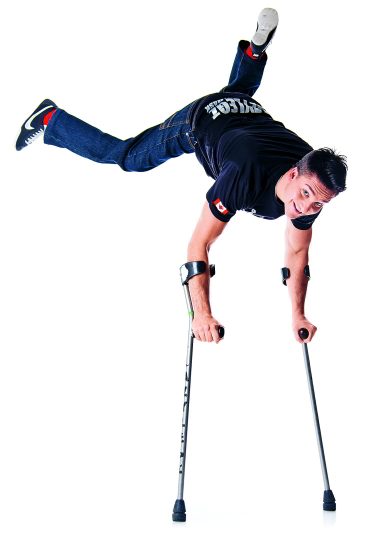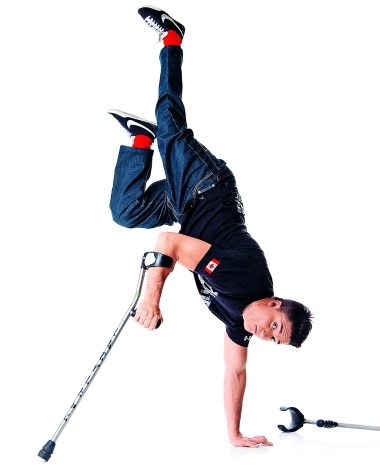
Standing at the back of a college pub in Washington, D.C., Luca Patuelli watched eagerly as two older kids faced off in battle. Flipping, tumbling and spinning at high velocity, the b-boys-inheritors of a breakdancing legacy that first emerged in New York’s black and Puerto Rican communities in the 1970s-were whirling dervishes of aggression and grace.
They were impressive, no question-yet so was Patuelli. Born with arthrogryposis, a disorder characterized by joint hardenings that can limit movement, he underwent his first operation at seven months. Fifteen more procedures followed, including, at age 13, one to insert a rod into his spine to relieve his scoliosis. But Patuelli was committed to motion. A skate brat, he got around by kneeling on his board and pumping the ground with his hands. When knee surgery ended that, he made his way on crutches, his legs in braces. Looking at the b-boys, the 15-year-old realized he could do something they couldn’t.
Dumping his gear in a corner, Patuelli crawled through the crowd to the middle of the dance circle and began doing planche push-ups-a hugely difficult move performed without touching your legs or feet to the ground, and requiring tremendous upper-body strength. Because Patuelli mostly used his arms in daily life, and because his legs were so small and light, he’d been planching for years. The audience erupted: “They were like, ‘That’s so cool. The kid with no legs is fly,'” recalls Patuelli.

In 2002, Patuelli returned to Montreal-where he was born-following his youth in the D.C. area. Boasting one of Canada’s oldest hip-hop scenes, the city is a breaking hot spot. He quickly found a foothold, which he leveraged into a globe-trotting career, often competing against non-disabled dancers on TV shows like So You Think You Can Dance Canada, and at dance festivals around the world.
While he isn’t the first b-boy with a disability-that distinction likely belongs to a 33-year-old French-Congolese man named Junior-Patuelli is the first Canadian to use crutches in a routine. Arthrogryposis, for all its challenges, has been a creative boon. Because his shoulder movement is restricted, Patuelli can’t do handstands, but there are workarounds: near-handstands achieved by balancing on one elbow and shifting his head to the side. And there’s always his signature footwork, courtesy of his “lazy” legs. Part of b-boying’s appeal is tied to the improvisation skills required in battle. That spontaneity, that emphasis on individuality, is attractive to dancers with physical challenges. “That’s the beauty of b-boying,” says Patuelli. “You can be yourself and get recognized for it.”

In that spirit, Patuelli founded the international crew ILL-Abilities seven years ago. The troop-whose slogan is “No excuses, no limits”-is made up of four other dancers from the United States, Chile, Holland and Japan, whom he met at various competitions. The men tour the world, honing their battle skills and delivering motivational performances. Because each dancer has a different disability-Checho was born with a malformation in his lower body; cancer forced Tommy Guns to have his right leg amputated; partially deaf from birth, Kujo has difficulty hearing music; Redo doesn’t have a right elbow joint or a right hip-they tailor their choreography accordingly. “‘Ill’ means sick,” Patuelli says, “but it also means incredible. We all have incredible abilities.”
A convincing speaker, Patuelli claims he has no set mission. “I’m just trying to be myself,” he says. “If people want to support me, cool.” Yet there’s no doubt he’s taken on a very serious project: to fire up people with disabilities and change the way society sees them.
One night in 2008, Patuelli gave a talk and performance at McGill University in Montreal. A dark-haired occupational therapist named Melissa Emblin sat in the audience. As she watched Patuelli warm up, Emblin, also a dancer, realized her heart was racing. After the show, she approached him and asked if he’d had an occupational therapist as a child. “He laughed and said, ‘No, I don’t know what that is,'” she recalls. “Then he invited me to a party.” Emblin and Patuelli got married last year; they said their vows in an alleyway, a symbol of their shared love of hip hop.
The pair’s partnership, however, isn’t simply romantic. In 2011, along with their friends Eric Martel and Marie-Élaine Patenaude, they co-founded an organization called Project RAD, which is helping Montreal-area dance schools become more accessible to the disabled. Emblin, who started out as a jazz and ballet dancer before embracing hip hop, had already been holding group sessions for some of her clients.
At the same time, Patuelli was teaching classes at a school for students with special needs. “We realized there wasn’t anything being offered outside the therapy room or specialized schools,” Emblin says. “We thought we should get these kids out in the community as part of a regular dance studio.”
Project RAD works with any dance studio that is at floor level or provides wheelchair access. If the studio is unable to pay for minor adjustments, such as widening doors or installing bars in toilet stalls, Project RAD covers part of the cost with proceeds from Patuelli’s performances. The team then either brings in its own instructors or trains the studio’s teachers to give classes. Since its founding, the organization has certified five studios in the Montreal area, with two more slated to be ready this fall. About 50 students, with a wide range of physical and intellectual disabilities, participate in the weekly sessions. “We focus on the idea that the littlest gesture makes the biggest difference,” Patuelli says. “We create games to make sure every child can create a movement based on their capacities.”
During a typical Project RAD session, each student is asked to invent a move. Then, his or her classmates imitate that gesture as best they can. A child with autism may start by stomping his legs; the girl in the wheelchair opposite him might not be able to stomp, but she can mimic that movement using her arms or lifting her legs from side to side. Later, the kids form dance duos, run through exercise drills or work on choreography.
The classes are deliberately scheduled in between a studio’s regular sessions to encourage interaction between the disabled and non-disabled students. That way, each cohort gets to mingle with the other, breaking down barriers. According to Patuelli, there has even been some creative cross-pollination. One evening, a student with cerebral palsy whose legs twitch naturally was practising his b-boy freezes. A dancer waiting for the following class stood observing him, then began trying to imitate the move.
Claudine Lanoix has witnessed the Patuelli effect first-hand. Her twin sons, Mathieu and Michel, both have cerebral palsy. They first met Patuelli nine years ago, when he was delivering a motivational performance at a special-needs school in Montreal. Michel was shy and quiet, but once he saw Patuelli dance, he got out of his wheelchair by himself for the first time. “He crawled through the gymnasium past all the other kids and started dancing with Luca,” Claudine says.
The twins stayed in touch with Patuelli and currently attend Project RAD classes. According to Claudine, her now-20-year-old sons have been transformed: their self-esteem bolstered, they’re unafraid to meet new people. In Mathieu’s case, the classes have broadened his range of movement and improved his ability to walk. “Our lives revolve around Luca,” says Claudine. “He’s an integral part of our family.” Perhaps most crucially, the twins no longer see cerebral palsy as an impediment.
Patuelli’s message-set mission or not-is clearly catching on. More than just a positive thinker, he remains almost pathologically upbeat. “We lose a lot of patience on the stupid things, but if we took the time to listen and to understand each other, we’d have a much more productive society,” Patuelli says. “When you see a person with a disability, people tend to make assumptions that they can’t do something. Essentially, I’d like the idea of disability to be cool,” he says, and laughs.